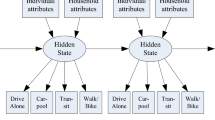Abstract
We describe latent factor probability models of human travel, which we learn from data. The latent factors represent interpretable properties: travel distance cost, desirability of destinations, and affinity between locations. Individuals are clustered into distinct styles of travel. The latent factors combine in a multiplicative manner, and are learned using Maximum Likelihood.
We show that our models explain the data significantly better than histogram-based methods. We also visualize the model parameters to show information about travelers and travel patterns. We show that different individuals exhibit different propensity to travel large distances. We extract the desirability of destinations on the map, which is distinct from their popularity. We show that pairs of locations have different affinities with each other, and that these affinities are partly explained by travelers’ preference for staying within national borders and within the borders of linguistic areas. The method is demonstrated on two sources of travel data: geotags from Flickr images, and GPS tracks from Shanghai taxis.
Access this chapter
Tax calculation will be finalised at checkout
Purchases are for personal use only
Preview
Unable to display preview. Download preview PDF.
Similar content being viewed by others
References
Brockmann, D., Hufnagel, L., Geisel, T.: The Scaling Laws of Human Travel. Nature 439(7075), 462–465 (2006)
Calabrese, F., Di Lorenzo, G., Liu, L., Ratti, C.: Estimating Origin-Destination Flows Using Mobile Phone Location Data. Pervasive 10(4), 36–44 (2011)
Calabrese, F., Pereira, F.C., Di Lorenzo, G., Liu, L., Ratti, C.: The geography of taste: Analyzing cell-phone mobility and social events. In: Floréen, P., Krüger, A., Spasojevic, M. (eds.) Pervasive 2010. LNCS, vol. 6030, pp. 22–37. Springer, Heidelberg (2010)
Chen, C.-Y., Grauman, K.: Clues from the Beaten Path: Location Estimation with Bursty Sequences of Tourist Photos. In: Proc. CVPR (2011)
Cho, E., Myers, S.A., Leskovec, J.: Friendship and Mobility: User Movement in Location-Based Social Networks. In: Proc. KDD (2011)
Colizza, V., Barrat, A., Barthelmy, M., Valleron, A.-J., Vespignani, A.: Modeling the Worldwide Spread of Pandemic Influenza: Baseline Case and Containment Interventions. PLoS Med. 4(1) (2007)
Dearman, D., Sohn, T., Truong, K.N.: Opportunities Exist: Supporting the Development of Spatial Knowledge with Continuous Place Discovery for Activities. In: Proc. CHI (2011)
Eagle, N., Pentland, A.: Reality mining: sensing complex social systems. Pers. Ubiquit. Comput. 10, 255–268 (2006)
Girardin, F., Calabrese, F., Fiore, F., Ratti, C., Blat, J.: Digital Footprinting: Uncovering Tourists with User-Generated Content. Pervasive Computing 7(4), 36–43 (2008)
Girardin, F., Fiore, F.D., Ratti, C., Blat, J.: Leveraging explicitly disclosed location information to understand tourist dynamics: A case study. J. of Location Based Services 2(1), 41–56 (2008)
González, M.C., Hidalgo, C.A., Barabási, A.-L.: Understanding individual human mobility patterns. Nature 453(7196), 779–782 (2008)
Guerzhoy, M., Hertzmann, A.: Learning latent factor models of human travel. In: NIPS Workshop on Social Network and Social Media Analysis: Methods, Models and Applications (2012)
Hoff, P.D.: Multiplicative latent factor models for description and prediction of social networks. Comp. & Math. Org. Theory 15, 261–272 (2009)
Horvitz, E., Apacible, J., Sarin, R., Liao, L.: Prediction, Expectation, and Surprise: Methods, Designs, and Study of a Deployed Traffic Forecasting Service. In: Proc. IJCAI (2005)
Hufnagel, L., Brockmann, D., Geisel, T.: Forecast and control of epidemics in a globalized world. PNAS 101(24), 15124–15129 (2004)
Kalogerakis, E., Vesselova, O., Hays, J., Efros, A., Hertzmann, A.: Image Sequence Geolocation with Human Travel Priors. In: Proc. ICCV (2009)
Kurashima, T., Iwata, T., Irie, G., Fujimura, K.: Travel route recommendation using geotags in photo sharing sites. In: Proc. CIKM (2010)
Neal, R.M., Hinton, G.E.: A view of the EM algorithm that justifies incremental, sparse, and other variants. In: Jordan, M.I. (ed.) Learning in Graphical Models, pp. 355–368. Kluwer Academic Publishers (1998)
Patterson, D.J., Liao, L., Fox, D., Kautz, H.: Inferring High-Level Behavior from Low-Level Sensors. In: Dey, A.K., Schmidt, A., McCarthy, J.F. (eds.) UbiComp 2003. LNCS, vol. 2864, pp. 73–89. Springer, Heidelberg (2003)
Peng, C., Jin, X., Wong, K.-C., Shi, M., Liò, P.: Collective Human Mobility Pattern from Taxi Trips in Urban Area. PLoS ONE 7(4) (2012)
Schein, A.I., Saul, L.K., Ungar, L.H.: A Generalized Linear Mmodel for Principal Component Analysis of Binary Data. In: Proc. AISTATS (2003)
Sohn, T., et al.: Mobility Detection Using Everyday GSM Traces. In: Dourish, P., Friday, A. (eds.) UbiComp 2006. LNCS, vol. 4206, pp. 212–224. Springer, Heidelberg (2006)
Yuan, J., Zheng, Y., Xie, X.: Discovering regions of different functions in a city using human mobility and pois. In: Proc. KDD (2012)
Author information
Authors and Affiliations
Editor information
Editors and Affiliations
Rights and permissions
Copyright information
© 2014 Springer International Publishing Switzerland
About this paper
Cite this paper
Guerzhoy, M., Hertzmann, A. (2014). Learning Latent Factor Models of Travel Data for Travel Prediction and Analysis. In: Sokolova, M., van Beek, P. (eds) Advances in Artificial Intelligence. Canadian AI 2014. Lecture Notes in Computer Science(), vol 8436. Springer, Cham. https://doi.org/10.1007/978-3-319-06483-3_12
Download citation
DOI: https://doi.org/10.1007/978-3-319-06483-3_12
Publisher Name: Springer, Cham
Print ISBN: 978-3-319-06482-6
Online ISBN: 978-3-319-06483-3
eBook Packages: Computer ScienceComputer Science (R0)




